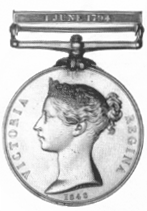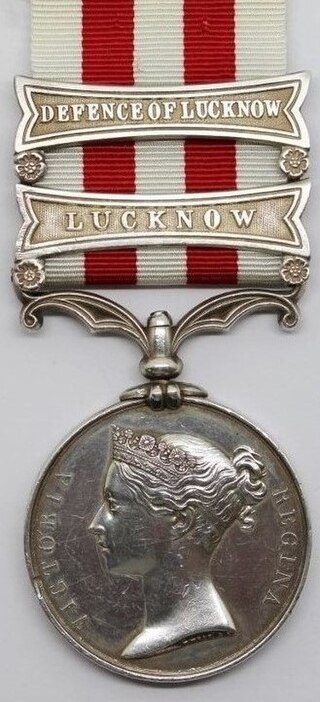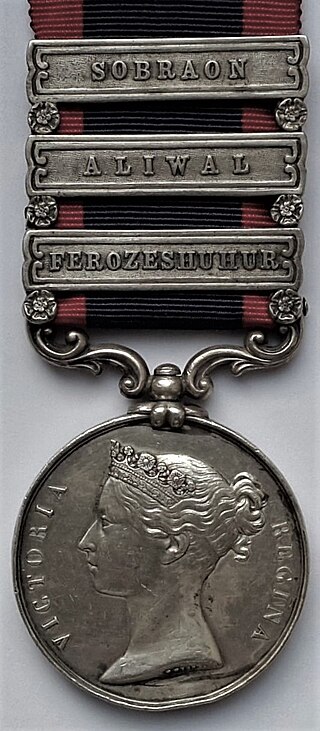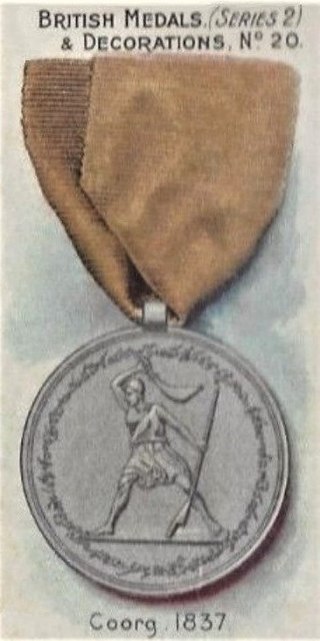Criteria
The Army of India Medal was approved on 21 March 1851 as a retrospective award by the Honourable East India Company, who bore the cost of the medal, [1] to survivors of various actions during the period 1803–1826. This period encompassed four wars: the Second Mahratta War (1803–04), the Gurkha War (1814–16), the Pindaree or Third Mahratta War (1817–18), and the First Burmese War (1824–26), together with the siege of Bhurtpoor (1825–26). [2] Each battle or action covered by the medal was represented by a clasp on the ribbon and twenty-one were sanctioned. [3] While the maximum awarded to one man was seven, [4] most medals were awarded with a single clasp.
The medal was only awarded to survivors and, as such, there are substantially fewer medals issued when compared with the number of men who served during this period. This was largely due to the extreme lapse of time between the wars commemorated and the issue of the medal—forty-eight years had passed between the first battle commemorated —Allighur in 1803—and the date of issue, 1851. A total of 4,500 medals were awarded. [2]
While the medal was awarded to both British and Indian soldiers on the same basis, the clasp Ava was only awarded to Europeans, since the Honourable East India Company had already awarded a medal for this Burma campaign to all native Indian soldiers present. [5]

The Naval General Service Medal (NGSM) was a campaign medal approved in 1847, and issued to officers and men of the Royal Navy in 1849. The final date for submitting claims was 1 May 1851. Admiral Thomas Bladen Capel was one of the members of the board that authorised the medal.

The Military General Service Medal (MGSM) was a campaign medal approved in 1847 and issued to officers and men of the British Army in 1848.

The India General Service Medal was a campaign medal approved on 1 March 1854, for issue to officers and men of the British and Indian armies. It was awarded for various minor military campaigns in India and nearby countries, between 1852 and 1895.

The Indian General Service Medal was a campaign medal approved on 1 January 1909, for issue to officers and men of the British and Indian armies. From 1919, it was also awarded to officers and men of the Royal Air Force, with the Waziristan 1925 clasp awarded solely to the RAF.

The Indian General Service Medal was a campaign medal approved on 3 August 1938, for issue to officers and men of the British and Indian armies, and of the Royal Air Force.

The Crimea Medal was a campaign medal approved on 15 December 1854, for issue to officers and men of British units which fought in the Crimean War of 1854–56 against Russia. The medal was awarded with the British version of the Turkish Crimea Medal, but when a consignment of these was lost at sea, some troops received the Sardinian version.

The Baltic Medal was a campaign medal approved on 6 June 1856, for issue to officers and men of the Royal Navy, Royal Marines, and Royal Sappers and Miners who served between March 1854 and August 1855 in the Baltic Sea operations against Russia in the Baltic theatre of the Crimean War, or Åland War. The medal primarily covered naval actions but was also awarded to 106 men of the Royal Sappers and Miners who were landed to place demolition charges against Russian fortifications at Bomarsund and Sveaborg.

The Indian Mutiny Medal was a campaign medal approved in August 1858, for officers and men of British and Indian units who served in operations in suppression of the Indian Rebellion of 1857.

The Sutlej Medal was a campaign medal approved in 1846, for issue to officers and men of the British Army and Honourable East India Company who served in the Sutlej campaign of 1845–46. This medal was the first to use clasps to denote soldiers who fought in the major battles of the campaign.

The India Medal was a campaign medal approved in 1896 for issue to officers and men of the British and Indian armies.

The British South Africa Company Medal (1890–97). In 1896, Queen Victoria sanctioned the issue by the British South Africa Company of a medal to troops who had been engaged in the First Matabele War. In 1897, the award was extended to those engaged in the two campaigns of the Second Matabele War, namely Rhodesia (1896) and Mashonaland (1897). The three medals are the same except for name of the campaign for which the medal was issued, inscribed on the reverse.

The Afghanistan Medal, sanctioned on 19 March 1881, was awarded to members of the British and Indian armies who served in Afghanistan between 1878 and 1880 during the Second Afghan War, the first war being from 1839 to 1842.

The China War Medal was issued by the British Government in 1843 to members of the British and Indian forces who took part in the First Opium War (1839–42). The medal was designed by William Wyon.

The Seringapatam Medal, or Sri Ranga Pattanam Medal, is a campaign medal that was awarded by the Governor-General of India to all British and Indian soldiers who participated in the British victory in the Battle of Seringapatam in 1799.

The Jellalabad Medal was a campaign medal issued by the British East India Company. It was established by Lord Ellenborough, the Governor-General of India, on 30 April 1842.
The medal was awarded for the defence of Jalalabad from 12 November 1841 to 7 April 1842, during the First Afghan War, to the troops under the command of Sir Robert Sale. About 2,600 soldiers took part, including the 13th Foot, the 35th Bengal Native Infantry, as well as detachments from other Indian Army units and some loyal Afghan forces.

The Khedive's Star was a campaign medal established by Khedive Tewfik Pasha to reward those who had participated in the military campaigns in Egypt and the Sudan between 1882 and 1891. This included British forces who served during the 1882 Anglo-Egyptian War and the subsequent Mahdist War, who received both the British Egypt Medal and the Khedive's Star. Cast in bronze and lacquered, it is also known as the Khedive's Bronze Star.

The Java Medal is a campaign medal awarded by the Governor-General of India to soldiers of the armies of the Honourable East India Company (HEIC) who participated in the Invasion of Java in August and September 1811, during the Napoleonic Wars.

The Nepal Medal was awarded by the Honourable East India Company (HEIC) to native Indian officers, and Indian soldiers for particularly distinguished conduct, during the Anglo-Nepalese War of 1814–16.

The Burma Medal is a campaign medal awarded by the Governor-General of India to native Indian soldiers of the armies of the Honourable East India Company (HEIC) who participated in the First Burma War from April 1824 to February 1826.

The Coorg Medal was awarded by the Honourable East India Company (HEIC) to local forces who remained loyal during the Coorg rebellion of 1837.






















